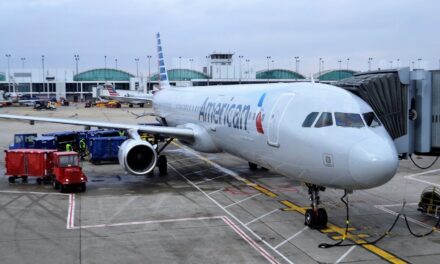Image by kikkuru0606
United Airlines (UAL) was forced to merge with Continental Airlines because of anemic strategic planning and poor execution. It was a $3-billion merger with about 1,200 jets and more than 86,000 workers.
Sadly, after eight decades, UAL’s logo became history. The Continental logo remains.The merger entailed a mega review of 2,000 policies and procedures.
UAL’s loading procedure prevailed — for the fastest-possible boarding time — window passengers seated first, and aisle passengers seated last.
Its policy for loading pets remains – they’re loaded onto the jets’ tail — first. Amen.
But starting with the new branding slogan, “Let’s Fly Together,” one had to wonder if the airline will ever get it right.
The slogan didn’t convey a fun experience with value and safety.
Nor does its slogan, “United Together” introduced in 2020 in a reference to the global COVID-19 pandemic.
When the student is ready, the teacher appears. In a dubious way, management at UAL is our teacher in strategic planning.
History of good planning?
In 2002, I wrote an uncomplimentary commentary about UAL’s management. UAL’s bankruptcy filing was a major concern to businesses, investors and workers. It was the largest airline bankruptcy in the nation’s history.
UAL comprised about 10 percent of Boeing Capital’s $11.5 billion loan portfolio as a result of jet deliveries to UAL.
Boeing’s move to Chicago, which is also UAL’s home, made it easier for the manufacturer to monitor bankruptcy proceedings and to persuade the airline to make good on its financial commitments. My sense was that other reasons included the attitude of labor, the Washington State Legislature’s approach to business and the need to be close to money markets and be more centrally located for stakeholders.
In May 2005, UAL’s plan to terminate employee pensions – the largest corporate pension default in U.S. history – was approved by the bankruptcy judge. UAL managed to dump its pension obligations on the Pension Benefit Guaranty Corporation (PBGC).
In Oct. 2005, the airline got a $3 billion loan from JPMorgan Chase & Co. and Citigroup Inc., and emerged from bankruptcy in Feb. 2006.
But starting with the new branding slogan, “Let’s Fly Together,” one has to wonder if the airline will get it right.
The slogan does not convey a fun experience with value and safety.
Poor ESOP model
In the wake of UAL’s financial collapse, it might have seemed logical to rebuke employee-owned companies, or employee stock ownership plans.
UAL’s failure was not a reflection of ESOPs but it provided lessons in developing a productive business model and operating a complex enterprise. After all, there are more than 11,000 successful employee-owned companies throughout the nation.
The ESOP concept evolved when it was theorized that company employees are more productive when they feel a sense of ownership. But UAL’s ESOP was established for the wrong reasons in 1994.
You might recall the acrimony at UAL when the CEO, Stephen Wolf, threatened to break up the airline and outsource maintenance projects. Instead, Mr. Wolf was given $30 million to walk away as the unions embarked on their plan to save thousands of jobs.
UAL essentially became an employee-owned company, 55 percent of the shares, in 1994. Employees gave up some $700 million in wages and conceded some work rules. In exchange, the workers bought out the boss and stockholders.
The TV ads were glitzy and impressive as UAL’s stock ultimately soared above $100 a share in 1997. Then it happened: The concept was failing and UAL’s TV ads touting the airline as an employee-owned company disappeared from the airwaves. The sky-high stock price began to descend.
Published reports in 2002 indicated union members needed to conduct a reality check about their misdirected anger – they blamed the Air Transportation Stabilization Board for refusing to make a $1.8 billion loan to UAL.
There are good reasons why UAL’s ESOP failed to blossom and the bud fell off the rose. It wasn’t because of 9/11, or because the airline was refused the government bailout.
Simply put, harmony and healthy participatory management are needed for ESOP success. UAL’s ESOP proved to be an anomaly – management and employees were not united.
Strategic-planning lessons
Of the 14 major airlines before 1978, only six remained in 2002. Like the 120 carriers that have failed in recent decades, UAL failed because of an unproductive business model:
Infrastructure. Bigger isn’t always better. In 2002, UAL was the second-largest carrier behind American Airlines. It dropped to fourth in passengers flown. UAL had unsuccessfully operated hubs in Washington D.C., Chicago, Denver, San Francisco, and Los Angeles. A modified hub system with more direct flights would have been less costly to operate.
Did UAL finally learn that it will have more leverage if it limits its purchases to one manufacturer? No. UAL bought from both Boeing and Airbus.
Uniformity. It only seems logical and cost-effective to operate a single aircraft brand for the majority of operations instead of a hodgepodge of planes. There are usually rewards for being loyal to vendors, including cost savings in purchases of jets and parts, as well as maintenance and operation simplification with one aircraft line instead of multiple aircraft makes.
Finally in 2009, UAL began negotiating with Airbus and Boeing for the purchase of 150 fuel-efficient planes to replace part of its aging fleet. Given its balance sheet, it was anticipated that UAL would depend heavily on the manufacturers for financing.
Did UAL finally learn that it will have more leverage if it limits its purchases to one manufacturer? No. UAL bought from both Boeing and Airbus.
Market conditions. Yes, airlines have had a tough time, especially because of fuel prices and passenger demand. But profitable airlines have consistently utilized economic principles, such as a no-frills approach, while UAL failed to adapt in losing $8 million a day. UAL lost $2.1 billion in 2001 and $1.74 billion for the first nine months of 2002.
UAL’s losses continued throughout the decade. For example, it lost $792 million in Q3 2008. In 2009, UAL failed to capitalize on plunging fuel prices. Its 2009 Q3 fuel bill decreased almost 57 percent or 1.1 $1.1 billion, but the airline lost $57 million.
Contrast UAL with Alaska Airlines, which netted $13.1 million in Q1 2010, and that’s typically its weakest-earning quarter each year. Alaska ranks well in on-time performance.
Failure to keep arms length from employees. With adversarial union leaders represented at the board level, it was impossible to keep labor costs at a realistic level.
Corporate welfare. In 2002, I pointed out this disturbing incident: Behind the scenes, the Air Transportation Stabilization Board had allowed accountants from competing carriers to examine UAL’s financials. They pointed out numerous flaws; consequently, the board gave the carrier several opportunities to revise its deficient business plan. UAL failed to do so.
Again, the company dumped its underfunded pension obligations on the PBGC. CEO Glenn Tilton kept his $4.5 million pension and is paid$10.3 million a year – considerably more than his peer airline CEOs.
Management. With due respect, Mr. Tilton was hired to save the company without sufficient airline experience. He was recruited from the oil industry. Plus, it takes a strong, non-confrontational administrator to cope with such challenges, and his team wasn’t strong enough to offset his weak points.
It’s also unfortunate that Mr. Tilton failed to avoid nearly $400 million in losses on fuel hedges in recent years – despite his decades of experience in oil.
In terms of strategic planning, UAL has not flown high, but had started to show some signs of corporate wisdom.
UAL started the process of improving its infrastructure. For example, it laid-off 36 employees at Manchester-Boston Regional Airport, and cut capacity in half because its two flights to Chicago’s O’Hare airport have been replaced by United Express and its smaller aircraft. This was part of UAL’s plan to cut its overall capacity by 10 percent.
Failure to honor tradition. Regarding the purchase of new planes, tradition and relationships should have been considered by the airline. Yes, UAL operates outside the U.S., too, with flights to Asia, Europe and Latin America with 3,300 flights to more than 200 destinations.
But my sense is UAL should have only gone with Boeing for three basic reasons:
— In recognition of its Boeing roots starting eight decades ago
— Boeing’s past goodwill in service
— Boeing’s risk-taking in extending more than $1 billion in financing to the carrier
Customer service. Consider UAL’s rankings in The Air Travel Consumer Report in 2008 by the Department of Transportation’s Office of Aviation Enforcement and Proceedings:
On-Time Arrivals: Near the bottom with 27.2 percent of its flights delayed.
Complaints: The worst.
Baggage Mishandling: United ranked 9th out of 19 places for baggage mishandling.
By September 2011, UAL still didn’t rank well in on-time flights – ranked third in flight delays at an average of 84 minutes per delay, according to Air Travel Consumer Reports for 2011.
UAL could learn from Alaska Airlines. I’ve flown both and there is no comparison. Connecting flights and poor customer service are a nightmare. My business associates have made similar unsolicited comments.
Then there was Dave Carroll, a Canadian musician from Halifax. He spent more than nine months trying to get United to pay for damages caused by baggage handlers to his guitar.
So he retaliated with the following YouTube video, which was viewed by at least six million people.
The merged airline has a long way to travel if it’s going to successful.
From the Coach’s Corner, here are strategies for mergers and acquisitions:
If a Merger & Acquisition Tempts You, Consult Your HR Pro First — If you’re contemplating a merger, be very careful about your human capital – whether you’re in the public sector, a small business or a global company.
Like Creating a Healthy Salad, M&As Need Key Ingredients — Mergers and acquisitions (M&As) might seem simple in small business. But for success in either small or big business, M&As are a complex process. They require the right ingredients much like building a great-tasting, healthy salad.
Buy a Business to Grab Market Share but Study 10 Financials — One of the fastest ways to grow is to buy a competitor or to acquire another business. But you must exercise due diligence in 10 steps.
Selling Your Mid to Large-Size Business? Beware of the Obstacles — With plenty of angst and working long hours, you’ve spent a lifetime building your company. Now, you’re dreaming about an exit strategy – selling out before your retirement for easy living. Perhaps you’ve exhausted so much time and energy growing your company you haven’t given any thought to the business-selling process. Here are recommended strategies.
“If black boxes survive air crashes, why don’t they make the whole plane out of that stuff?”
-George Carlin
__________






